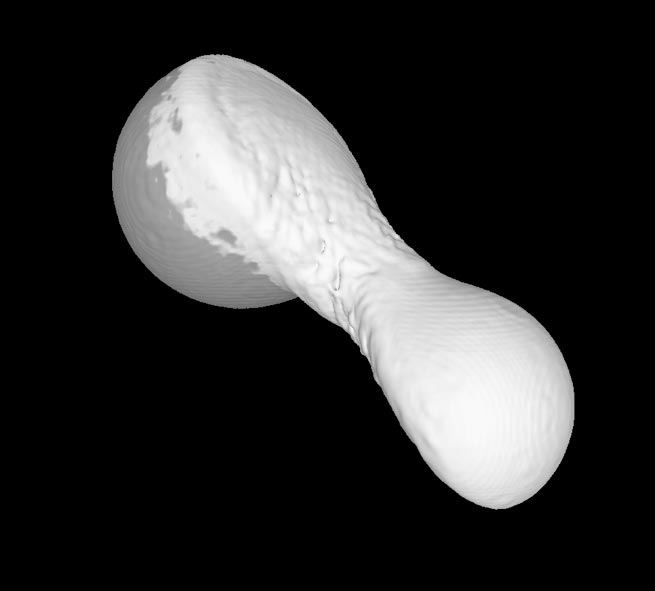How comets were assembled

Zusammenstoss zwischen zwei eisigen, ca. 1 Kilometer grossen Objekten. Nach einer ersten Kollision trennen sich die Körper und stossen einen Tag später wieder zusammen. Simulation: Jutzi/Asphaug
In a video sequence based on a computer simulation two icy spheres with a diameter of about one kilometer are moving towards each other. They collide at bicycle speed, start to mutually rotate and separate again after the smaller body has left traces of material on the larger one.
The time sequence shows that the smaller object is slowed down by mutual gravity. After about 14 hours it turns back and impacts again a day after the first collision. The two bodies finally merge to form one body that somehow looks familiar: The bi-lobed frame resembles the shape of comet 67P/Churyumov-Gerasimenko imaged by ESA’s Rosetta mission.
100 simulations performed
The simulation is part of a study published in «Science Express» by Bernese astrophysicist Martin Jutzi and his US colleague Erik Asphaug (Arizona State University). With their three-dimensional computer models the researchers reconstruct what happened in the early solar system.
«Comets or their precursors formed in the outer planets region, possibly millions of years before planet formation», explains Martin Jutzi. «Reconstructing the formation process of comets can provide crucial information about the initial phase of planet formation, for instance, the initial sizes of the building blocks of planets, the so-called planetesimals or cometesimals in the outer solar system.»
About 100 simulations were performed, each of them taking one to several weeks to complete, depending on the collision type. The work was supported by the Swiss National Science Foundation through the Ambizione program and in part carried out within the frame of the Swiss National Centre for Competence in Research «PlanetS».
67P/Churyumov-Gerasimenko isn’t the only comet showing a bi-lobed shape and evidence for a layered structure. Crashing on 9P/Tempel 1 in 2005, NASA’s Deep Impact showed similar layers, a feature that is also presumed on two other comets visited by NASA missions.
Half of the comet nuclei that spacecraft have observed so far – among them comets 103P/Hartley 2 and 19P/Borelly – have bi-loped shapes. «How and when these features formed is much debated, with distinct implications for solar system formation, dynamics, and geology», says Martin Jutzi.
Primordial remnants of a quiet phase
In their study, the researchers applied 3D collisional models, constrained by these shape and topographic data, to understand the basic accretion mechanism and its implications for internal structure. As their three-dimensional computer simulations indicate, the major structural features observed on cometary nuclei can be explained by the pairwise low velocity accretion of weak cometesimals. The model is also compatible with the observed low bulk densities of comets as the collisions result in only minor compaction.
«These slow mergers might represent the quiet, early phase of planet formation around 4.5 billion years ago, before large bodies excited the system to disruptive velocities, supporting the idea that cometary nuclei are primordial remnants of early agglomeration of small bodies», says Martin Jutzi. Alternatively, the same processes of coagulation might have occurred among debris clumps ejected from much larger parent bodies. Along with future space missions using radar to directly image internal structure, the 3D computer simulations are an important step to clarify the question of how the cometary nuclei were assembled.
Publication details:
M. Jutzi, E. Asphaug, «The shape and structure of cometary nuclei as a result of low velocity accretion», Science Express, 2015
Media Contact
All latest news from the category: Physics and Astronomy
This area deals with the fundamental laws and building blocks of nature and how they interact, the properties and the behavior of matter, and research into space and time and their structures.
innovations-report provides in-depth reports and articles on subjects such as astrophysics, laser technologies, nuclear, quantum, particle and solid-state physics, nanotechnologies, planetary research and findings (Mars, Venus) and developments related to the Hubble Telescope.
Newest articles

Silicon Carbide Innovation Alliance to drive industrial-scale semiconductor work
Known for its ability to withstand extreme environments and high voltages, silicon carbide (SiC) is a semiconducting material made up of silicon and carbon atoms arranged into crystals that is…

New SPECT/CT technique shows impressive biomarker identification
…offers increased access for prostate cancer patients. A novel SPECT/CT acquisition method can accurately detect radiopharmaceutical biodistribution in a convenient manner for prostate cancer patients, opening the door for more…

How 3D printers can give robots a soft touch
Soft skin coverings and touch sensors have emerged as a promising feature for robots that are both safer and more intuitive for human interaction, but they are expensive and difficult…





















